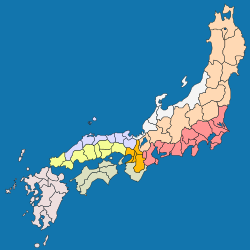Chūbu region
Chūbu region (中部地方, Chūbu-chihō) is one of Japan's traditional regions.[1] The Japanese conventions of geography and history divide the nation into eight regions, including the Chūbu region.[2] These have been used since 1905 as basic units for description and comparison[3] and as cultural markers.
The regions of Japan are a fusion of historical divisions and modern administrative needs".[4] The significance of the region in Japan is geographical, cultural and administrative.[5]
History
In the late 7th century, the Hokuridō was identified as one of the eight largest administrative areas of the Imperial system (ritsuryo seido).
Gokishichidō is an ancient system of names for parts of the country, including Hokuridō.[6] Chūbu covers a central part of the island of Honshū[7] in roughly the same area as the traditional Hokuriku, Kōshin'etsu and Tōkai.
In the Meiji period, the modern regional system was made by Imperial decree. Japan was divided into regions (chihō Archived 2017-03-24 at the Wayback Machine), including the Hokuriku and Tokai or Chūbu region. A regional council (chihō gyōsei kyōgisai) was headed by the governor of the most powerful prefecture in the regional grouping. The council also included regional chiefs of central government ministries.[8]
Table: Chūbu region
| Province | Province capital |  Pre-modern regions |
Prefecture | Prefecture capital |  Regions today |
Notes |
|---|---|---|---|---|---|---|
| Echigo | Hokurikudō | Niigata[9] | Niigata | Chūbu | created from Koshi in late-7th century | |
| Echizen | Echizen | Hokurikudō | Fukui | Fukui | Chūbu | created from Koshi in late-7th century |
| Etchū | Takaoka | Hokurikudō | Toyama[9] | Toyama | Chūbu | created from Koshi in late-7th century |
| Kaga | Hokurikudō | Ishikawa[9] | Kanazawa | Chūbu | created in 823 from Echizen | |
| Noto | Nanao | Hokurikudō | Ishikawa | Kanazawa | Chūbu | created in 718 from Echizen, then part of Etchū in 741; split from Etchū in 757 |
| Sado | Sado | Hokurikudō | Niigata | Niigata | Chūbu | occupied in 743 by Echigo, later re-split in 752 |
| Wakasa | Obama | Hokurikudō | Fukui[9] | Fukui | Chūbu |
Over time, Chūbu has developed its own regional dialects, customs and unique traditional culture.[10]
Geography
The Chūbu region is a large area of Honshū. Chūbu has traditional subddivisions, including Hokuriku, Kōshin'etsu, Shin'etsu, and Tōkai.
Chūbu Region Media
Mount Fuji is the Chūbu region's most famous landmark.
Related pages
References
- ↑ Nussbaum, Louis-Frédéric. (2005). "Geography" in Japan Encyclopedia, p. 242; "Chūbu", p. 126.
- ↑ Library of Congress Country Studies, Japan (LOC), "Geographic Regions"; "The islands of Hokkaido, Shikoku, and Kyushu each form a region, and the main island of Honshu is divided into five regions". Retrieved 2012-4-15.
- ↑ Tames, Richard. (2008). A traveller's history of Japan, p. 264.
- ↑ Japan Ministry of Foreign Affairs (MOFA), "Regions of Japan". Retrieved 2012-4-15.
- ↑ Brandt, Kim. Kingdom of Beauty: Mingei and the Politics of Folk Art in Imperial Japan, pp. 218-219;Shapira, Philip et al. (1994). Planning For Cities And Regions In Japan, p. 193, citing Research Institute of Construction and Economy. (1991). "Fig. 2-7. "Regional Vitalization and Construction Administration," White Paper on Construction. Retrieved 2012-8-28.
- ↑ Nussbaum, "Goki-shichidō" at p. 255.
- ↑ LOC, "Chubu". Retrieved 2012-4-15.
- ↑ Steiner, Kurt. (1965). Local Government in Japan, p. 62.
- ↑ 9.0 9.1 9.2 9.3 Nussbaum, "Hokuriku" at p. 344,
- ↑ Web-Japan.org, "Regions of Japan". Retrieved 2012-4-15.
Other websites
| Wikimedia Commons has media related to Lua error in Module:Commons_link at line 62: attempt to index field 'wikibase' (a nil value).. |











